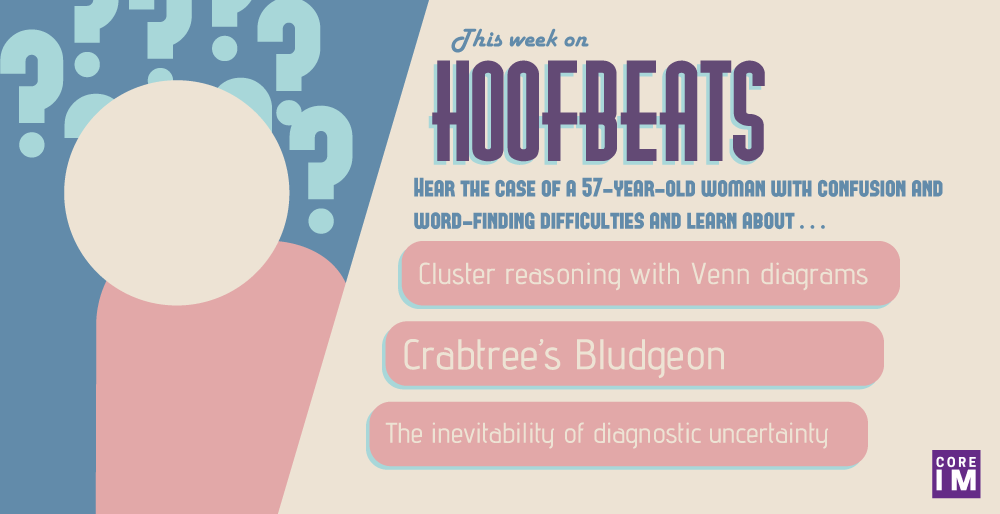Podcast: Play in new window | Download
Subscribe: RSS
By John Hwang MD, Cindy Fang MD, Michael Phillips MD, Shreya Trivedi MD || Audio Editing by Richard Chen || Graphic by Amy Ou MD
Time Stamps
- Case history and exam 00:40
- Causal models 11:24
- Facets versus diagnoses 13:25
- Problem representation 16:37
- Part two of the case 17:10
- Occam’s razor, Hickam’s dictum, and Crabtree’s bludgeon 23:00
- Diagnostic uncertainty 27:10
- Learning points 34:24
Subscribe to CORE IM on any podcast app! Follow us on Facebook @Core IM || Twitter @COREIMpodcast || Instagram @core.im.podcast. Please give any feedback at COREIMpodcast@gmail.com.
Show Notes
-
- Exploring all of the potential cause-and-effect relationships between the clinical findings in a case is a key step in the diagnostic process.
- When dealing with multiple clinical findings (in this case: fever, confusion and rash), the clinician must consciously decide whether to search for separate explanations for each, or to seek one explanation for all. The latter approach is called clustering, and while intuitive, can lead to serious errors if relied upon exclusively.
- Certain patterns of findings, while insufficient to make a specific diagnosis, allow the clinician to make inferences about the patient’s illness (e.g. fever, confusion, and CSF abnormalities as “encephalitisâ€). Diagnostic experts often construct many of these intermediate hypotheses (also called facets) to guide further data interpretation and reasoning, well before they propose specific diagnoses.
- Occam’s razor suggests that there is such a thing as the one true diagnosis. Hickam’s dictum suggests more often there are many true diagnoses. Crabtree’s Bludgeon questions whether any diagnosis can be safely considered “trueâ€, since ad hoc explication is so tempting for physicians.
- Observing a patient’s response to treatment (or non-treatment) can be a powerful diagnostic tool, especially when clinicians make the patient an active partner in its deployment.
- Diagnostic uncertainty in medicine is inevitable, as is the anxiety that accompanies it. Simply ignoring uncertainty can worsen a clinician’s cognitive biases; conversely, surrendering to uncertainty is paralyzing. Experienced clinicians explicitly acknowledge and even harness this anxiety in order to strengthen their clinical reasoning and decision-making.
References
- Kassirer JP, Kopelman RI. Learning Clinical Reasoning. 2nd Ed. Baltimore: Williams and Wilkins, 2010.
- Feinstein AR. An Analysis of Diagnostic Reasoning. II. The Strategy of Intermediate Decisions. Yale J Biol Med. 1973 Oct; 46(4):264-283.
- Arocha JF, Wang D, Patel VL. Identifying reasoning strategies in medical decision making: a methodological guide. Journal of biomedical informatics 2005;38:154-71.
- Patel VL, Arocha JF, Kaufman DR. Diagnostic Reasoning and Medical Expertise. Psychology of Learning and Motivation – Advances in Research and Theory. 1994;31(C):187-252.
- Gonzalez-Juanatey C, et al. Rheumatic manifestations of infectious endocarditis in non-addicts. A 12-year study. Medicine (Baltimore). 2001 Jan;80(1):9-19.
- Chami S., et al. Bacterial Endocarditis Presenting as Leukocytoclastic Vasculitis. Cureus. 2017 Jul;9(7):e1464. Available at doi: Â 10.7759/cureus.1464
- Ghosh G., et al. ANCA Positivity in a Patient with Infective Endocarditis-Associated Glomerulonephritis: A Diagnostic Dilemma. Yale J Biol Med. 2014 Sep; 87(3):373-377.
- Shinkins B, Perera R. Diagnostic Uncertainty: Dichotomies are not the Answer. Br J Pract 2013; 63(608):122-123. Available at https://doi.org/10.3399/bjgp13X664090
- Mani N, Slevin N. What Three Wise Men Have to Say About Diagnosis. BMJ 2011;343:d7769
- Alam R, et al. Managing Diagnostic Uncertainty in Primary Care: A Systematic Critical Review. BMC Family Practice. 2017 18:79.

